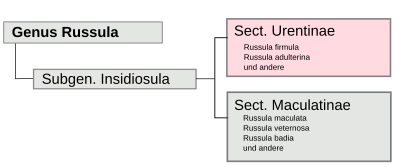Russula subsect. Cupreinae
| Russula subsect. Cupreinae | ||||||||||||
|---|---|---|---|---|---|---|---|---|---|---|---|---|
| Systematics | ||||||||||||
|
||||||||||||
| Scientific name | ||||||||||||
| Russula subsect. Cupreinae | ||||||||||||
| Receipt |
Russula subsect. Cupreinae is a subsection of the genus Russula , which is within the Insidiosinae section . The subsection corresponds to Romagnesi's Urentinae section.
features
The subsection usually contains small to medium-sized pigeons with and more or less pungent taste. The hats can be colored very differently. The palette ranges from purple, crimson, coppery red, green, yellow or brown. Sometimes they are also multicolored or reddish tones are mixed in. The brim of the hat is more or less clearly grooved or furrowed and the spore powder is yellow. The flesh is unchangeable or just graying slightly. Only in rare cases can the meat turn slightly yellow or brown. The pigeon can be found under both deciduous and coniferous trees.
The spores are thorny and often have isolated or only slightly burred warts that are rarely connected to one another. The Pileocystiden are mostly quite cylindrical or multiple septate and hyphae end cells are often more or less sagging.
Mycorrhizal Anatomy
The mycorrhizae of all kinds from the subsections Cupreinae have more or less strongly interlocking, pseudoparenchymatic mantle cells and sulfovanillin-positive gloeoplere cells , true cystids are absent. Within the group there are differences in the wall thickness of the hyphae cells and the formation of a gelatinous matrix.
- The type species is Russula cuprea , the purple-brown yolk-deaf .
Systematics
The systems of Bon and Romagnesi correspond with the difference that the taxon Cupreinae in Romagnesi is called Urentinae and has the rank of a section. The systems of Singer and Sarnari also use the taxon in the rank of a subsection, albeit under the name Urentes , whereby the subsection Urentes is within the Russula section for both .
| Receipt | Romagnesi |
|---|---|
 |

|
Molecular examinations of the ITS-rDNA show that the subsection Cupreinae and part of the subsection Laricinae , from the Tenellae section, are next to each other in the ITS-rDNA cladogram, while Russula nauseosa seems to be closer to the species of the Puellarinae subsection . Bons and Romagnesi's classification according to fruiting body characteristics seems questionable here and it remains to be seen whether it will last. The mycorrhizal anatomy cannot help here either, as there is extensive feature overlap within the Tenellae - Insidiosinae complex, so that neither the types of the two sections nor the types of their subsections can be separated.
| German species name | Scientific species name | author |
|---|---|---|
| Purple-brown yolk blubber | Russula cuprea | Secr. (1833) |
| Giant spore deaf | Russula gigasperma | Romagn. (1962) |
| Sharp glossy deaf | Russula firmula * | Jul. Schäff. (1940) |
| Sharp brown blubber | Russula adulterina | ( Fr. ) Peck (1940) |
| Flesh-colored hot deaf * | Russula cristata * | Romagn. (1962) |
| Russula cupreola * | Russula cupreola * | Sarnari (1990) |
| Russula luteoaurantia * | Russula luteoaurantia * | Romagn. ex Bon (1990) |
| Yellow-green leather puff * | Russula luteoviridans * | C. Martin (1894) |
| Green yolk deaf * | Russula urens * | Romell (1921) |
| Russula subcristulata * | Russula subcristulata * | Romagn. (1962) |
| Species marked with an asterisk are not generally recognized. | ||
literature
Individual evidence
- ↑ Marcel Bon (ed.): Parey's book of mushrooms . Franckh-Kosmos Verlag, Stuttgart 2005, ISBN 3-440-09970-9 , p. 72 .
- ^ Monographic Key to European Russulas (1988). (PDF; 1.4 MB) In: English translation by M. Bons Russula key :. The Russulales website, archived from the original on July 28, 2010 ; Retrieved May 21, 2011 .
- ^ A b Ludwig Beenken: The genus Russula: Investigations into their systematics based on ectomycorrhizae. (PDF, 27MB) Dissertation, LMU Munich: Faculty of Biology (2004). Retrieved May 21, 2011 .